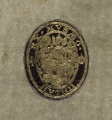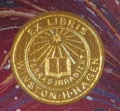Provenance: Difference between revisions
MeaghanBrown (talk | contribs) m (→List of notable former owners of Folger materials: added more owners pages) |
MeaghanBrown (talk | contribs) m (→External: added link to Findingaids in External reference section) |
||
| Line 5: | Line 5: | ||
=== External === | === External === | ||
Many of the Former Owners of Folger items collected more than books. Letters, miscellanies, receipts, ledgers, and library catalogues help trace books as they passed from one person or institution to another. For more information on specific former owners, a good place to start looking is http://findingaids.folger.edu/. For example, [[Edwin Booth]]'s letters discuss his dealings with booksellers (both buying and selling), his own writing, and books that he has read. | |||
=== Internal === | === Internal === | ||
Revision as of 09:24, 13 April 2015
Provenance is the record of ownership of an object. Provenance can be established through external records, such as sales receipts and booksellers' ledgers, and through internal marks and additions, such as ownership inscriptions and bookplates. Distinctions are often made in provenance studies between private owners and commercial dealers; this is not the case in Folger record keeping. All persons or entities who have had custody of an item, even if temporary, and even if we do not know their name, are considered "former owners" in Folger catalog records.
Types of evidence for establishing provenance
External
Many of the Former Owners of Folger items collected more than books. Letters, miscellanies, receipts, ledgers, and library catalogues help trace books as they passed from one person or institution to another. For more information on specific former owners, a good place to start looking is http://findingaids.folger.edu/. For example, Edwin Booth's letters discuss his dealings with booksellers (both buying and selling), his own writing, and books that he has read.
Internal
Signatures
Owner's names appear in many places in early modern books. While title pages and the first leaf of the text are common, names may appear throughout the work, and you can often find signatures on the final leaf or at random locations in the middle of a text.
Bookplates
Bookplates come in many sizes and materials including leather and vellum, but are commonly made of paper and pasted onto the front pastedown or flyleaves of the book. Bookplates often feature heraldic symbolism and family mottos. The Folger's own bookplate, which features Shakespeare's coat of arms, is often tipped to the back pastedown to avoid obscuring earlier provenance information.
The term "Ex Libris," often found on bookplates, translates as "From the library of."



